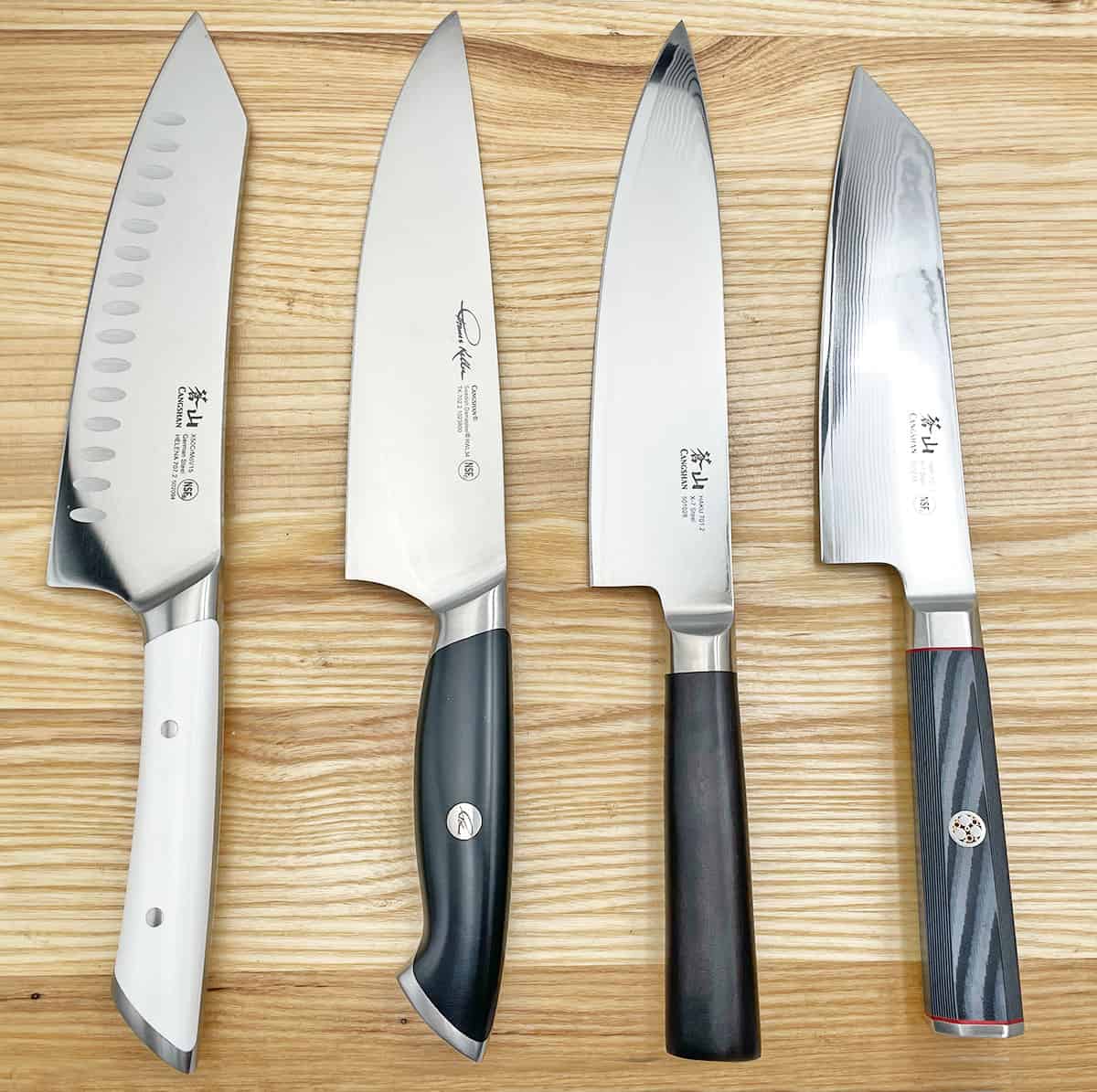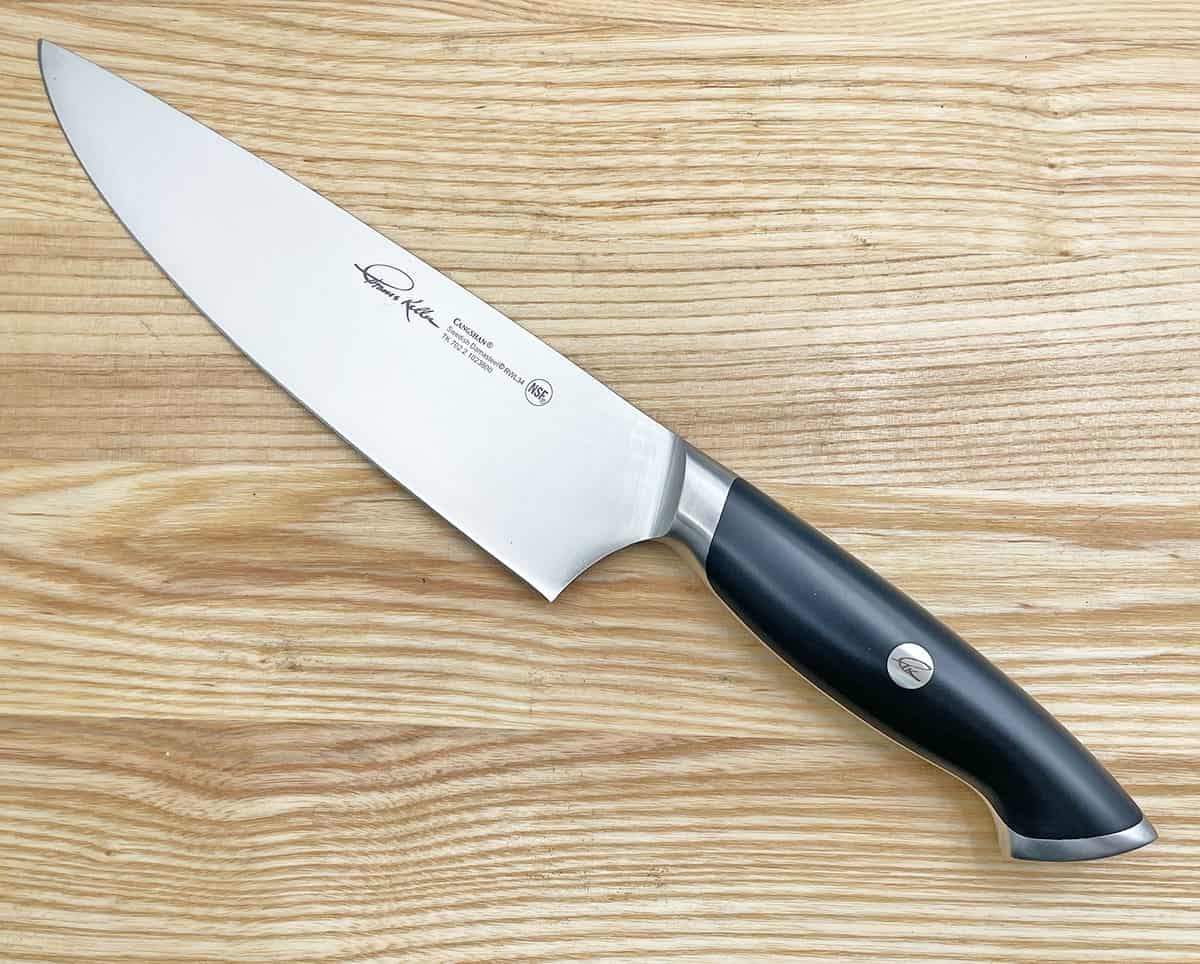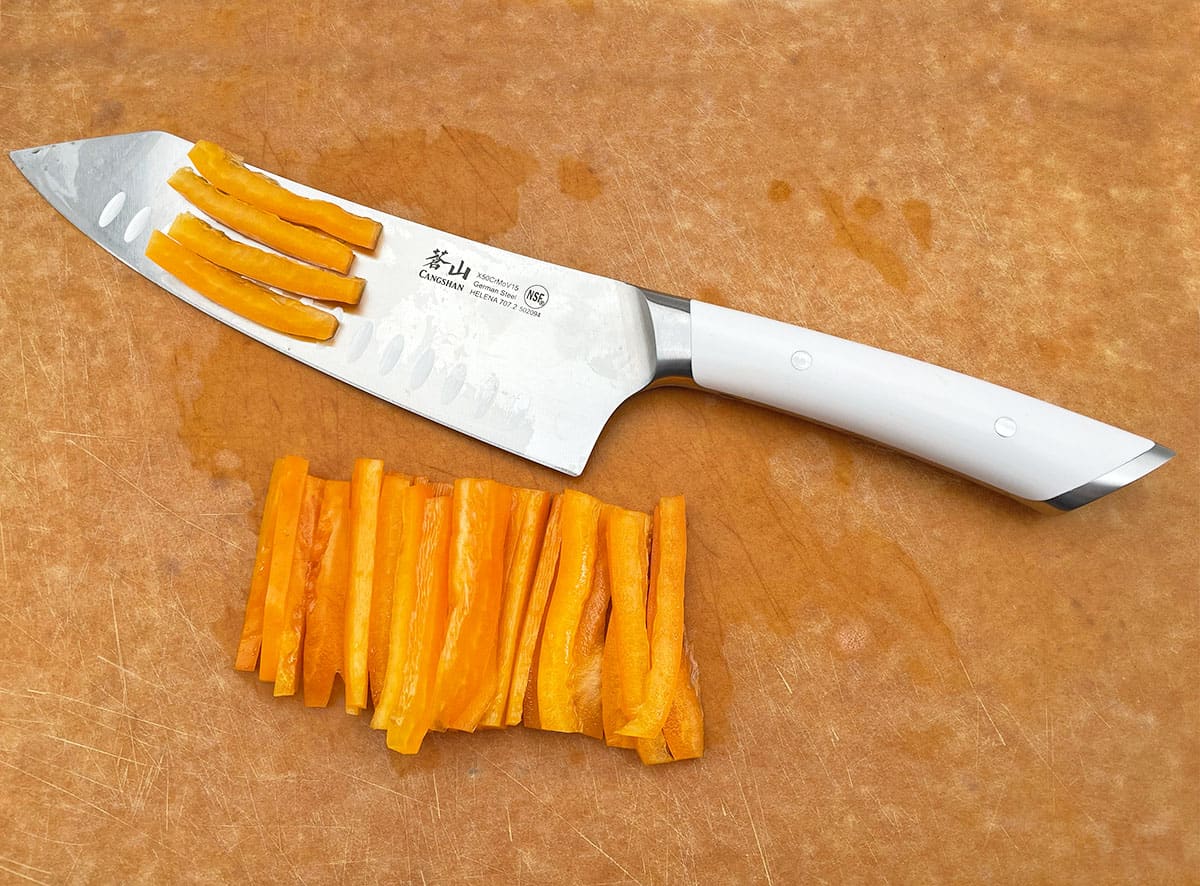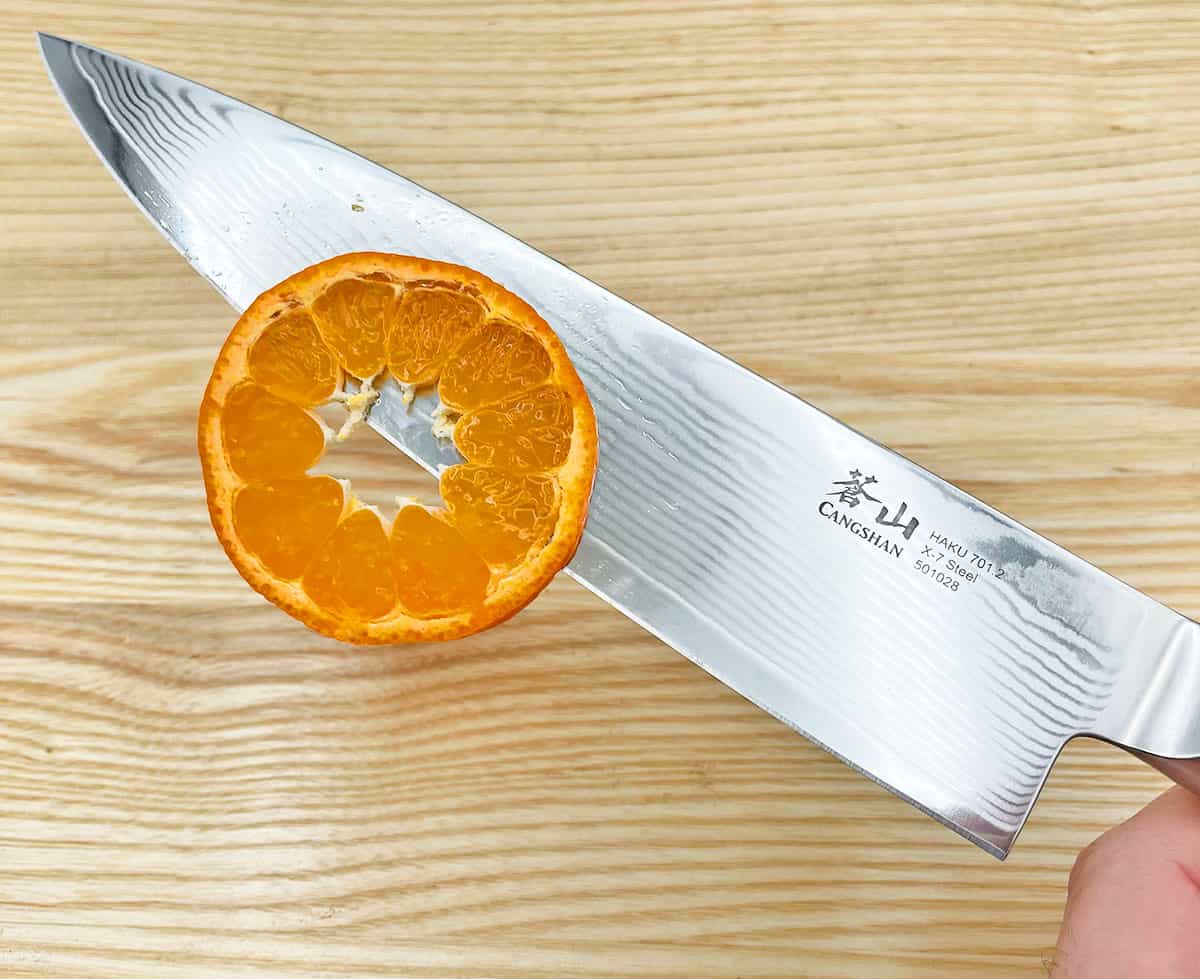Cangshan launched in 2015 but has already won several Red Dot Design Awards and has been featured on Oprah’s Favorite Things list twice.
But are these knives worth buying? What makes them special?
In this review, I break down the pros and cons of Cangshan knives. You’ll learn about their design, materials, performance, and more.
Use the links below to navigate the review:
- Cangshan Review: Key Takeaways
- Pros of Cangshan Knives
- Cons of Cangshan Knives
- Bottom Line: Are Cangshan Knives Worth Buying?
Cangshan Review: Key Takeaways
Throughout this review of Cangshan knives, I share detailed analysis, test results, and over a dozen close-up pictures. But if you only have a minute, here are the key takeaways.
Do you prefer to watch rather than read? I break down the pros and cons of Cangshan knives in the quick video below.
Pros of Cangshan Knives
- Variety: Cangshan offers over two dozen thoughtfully designed knife series with different blade shapes, styles, and sizes.
- High-Quality Steel: Cangshan carefully selects industry-leading steels like German X50CrMoV15, Swedish 14C28N, and Damasteel RWL34 that are known for hardness, edge retention, and corrosion resistance.
- Sharpness: Initial Cutting Performance (ICP) and Total Card Cut (TCC) testing shows that Cangshan knives have exceptional initial sharpness out of the box and edge retention through heavy use.
- Handle Design: Cangshan provides a range of comfortable and secure handle designs, including the octagonal “wa” handles (Yari Series) and sleek hollow all-steel handles (N1 Series).
- Sheaths: Most individual Cangshan knives come with custom-fit magnetic sheaths that protect the blade and promote safety.
- Price Range: Cangshan offers a wide range of prices across their two dozen series.
Cons of Cangshan Knives
- Fit and Finish: Cangshan knives have minor imperfections in fit and finish, including uneven handle gaps and asymmetrical blade grinds.
- Heavy: Cangshan’s heavyweight western-style knives that weigh over 9 oz can strain your wrist.
- Prone to Chipping: Cangshan uses hard steels over 60 HRC (14C28N and Damasteel RWL34) that are prone to chipping if you use them carelessly on bones or other hard ingredients.
- Unproven: Cangshan launched in 2015, so its long-term durability is not yet proven.
- Made In China: Cangshan knives are made in China, which leads to the perception that they are lower quality than those made in countries like Germany and Japan.
- Expensive: Compared to other brands that manufacture their knives in China and have a similar history, some Cangshan series are surprisingly costly.
Bottom Line
Cangshan knives have some minor imperfections, but their most important attributes – sharpness and edge retention – are excellent. Plus, the handles are comfortable, secure, and durable. With over two dozen thoughtfully designed series, Cangshan offers options for all preferences and budgets. Despite being a relatively new brand, their quality and performance make Cangshan knives a worthwhile investment.
Cangshan is available on Amazon, where you can check the current prices and read more reviews.
Pros of Cangshan Knives
The most noteworthy advantages of Cangshan knives are their high-quality steel and range of unique handles, but there’s much more. Let’s explore the benefits of Cangshan.
Variety
Cangshan offers a wide variety of knife series — over two dozen in total. Each series has a unique design and carefully selected materials to meet different needs.

Whether you prefer Western-style knives like the D Series, V2 Series, and S Series, or Asian-style knives like the Haku, Z Series, and Yari Series, Cangshan has you covered.
They also offer hybrid styles that blend attributes from both Western and Asian knives. For example, the TV2 series Nakiri knife has a traditional Japanese blade profile ideal for chopping vegetables, but it’s made from Swedish steel and has a Western-style riveted handle.
Some of Cangshan’s most popular series include the Thomas Keller Signature Collection, Yari, Haku, and Helena. Here’s a brief overview of each:
Thomas Keller Series: Designed by Michelin-starred chef Thomas Keller and crafted by Cangshan, this series features slightly curved blades ideal for slicing, mincing, and dicing. The knives are forged from Swedish Damascus steel, known for strength, hardness, and corrosion resistance. They undergo a 6-stage heat treatment process to achieve a Rockwell hardness of 61. This series won the 2019 Red Dot Design Award.

Yari Series: With a striking 67-layer Damascus pattern on the X-7 steel blades, these knives have an exceptionally sharp edge. The rich gray G10 handles provide comfort and precision. Each knife comes with a matching magnetic Saya-style wood sheath for protection.

Haku Series: Also featuring a 67-layer Damascus pattern on X-7 steel, the Haku series has African Blackwood handles for comfort and balance. The knives come with dark walnut wood sheaths shaped specifically for each blade.

Helena Series: With slim, ergonomic handles and full-tang X50CrMoV15 German steel blades, the Helena series is designed for comfort and durability. The knives are heat-treated and hand-sharpened to a 16° angle, resulting in a sharp, lasting edge.

The wide range of series Cangshan offers ensures you can find the perfect knife for your needs and style, whether you prefer Western or Asian-influenced designs.
High-Quality Steel
Cangshan utilizes several types of premium steel to craft their blades. This variety allows them to optimize different knives for specific needs (and budgets). Here’s a quick overview:

German X50CrMoV15: This steel contains 0.5% carbon and 15% chromium. It has an exceptional balance of hardness and durability for sharp, long-lasting edges. The high chromium content makes it highly stain-resistant. With a hardness of around 58 on the Rockwell scale, it holds an edge well without being prone to chipping like some harder Japanese steels. It’s a popular steel for German knives. Cangshan uses it for several series, including Elbert, Helena, and TN1.
German MA5: Similar composition to X50CrMoV15 but can be heat treated to achieve a hardness around 59 on the Rockwell scale. The additional hardness provides better edge retention, while the high chromium still ensures excellent stain resistance. Cangshan uses this steel for the Prazision series.
X-7: A proprietary steel developed by Cangshan to match the hardness of VG10 (around 61 Rockwell) without being as brittle. The 67 folded layers form a beautiful wavy Damascus pattern on the blade. With both hardness and durability, X-7 offers incredible edge retention and corrosion resistance. It’s utilized for the Haku and Yari series.

Swedish 12C27: Manufactured by Sandvik, this steel has about 0.6% carbon for hardness and 13.5% chromium for corrosion resistance. It’s easy to sharpen and achieves a nice balance of edge retention, strength, and hardness. It scores around 56 on the Rockwell hardness scale.
Swedish 14C28N: Another Sandvik steel, but with added nitrogen (0.11%) that enhances hardness up to about 60 Rockwell and boosts corrosion resistance. This fine-grained steel achieves a great blend of sharpness, edge retention, and toughness. Cangshan uses it for the Oliv, TC, and TS series.
Swedish Damasteel RWL34: RWL34 is a powdered steel with a fine grain structure for maximum strength, hardness (up to 62 Rockwell), and corrosion resistance. With high chromium and additional alloys like molybdenum and vanadium, it achieves exceptional performance. Cangshan uses this ultra-premium steel to make the blades in its Thomas Keller series.
The table below shows the type of steel used in each series:
| Knife Series | Blade Steel |
|---|---|
| Thomas Keller | Swedish Damasteel RWL34 |
| YARI | X-7 |
| ELBERT | German X50CrMoV15 |
| HAKU | X-7 |
| HELENA | German X50CrMoV15 |
| OLIV | Swedish 14C28N |
| TS | Swedish 14C28N |
| TN1 | German X50CrMoV15 |
| TC | Swedish 14C28N |
| S | German X50CrMoV15 |
| S1 | German X50CrMoV15 |
| TG | Swedish 12C27 |
| S+ | German X50CrMoV15 |
| L | German X50CrMoV15 |
| X | German X50CrMoV15 |
| Prazision | German MA5 |
| W | German X50CrMoV15 |
| SOBU | X-7 |
| N1 | German X50CrMoV15 |
| V2 | German X50CrMoV15 |
| Z | German X50CrMoV15 |
| D | German X50CrMoV15 |
| SAVEUR Selects | German X50CrMoV15 |
Sharpness
One of the first things I noticed when testing Cangshan knives is their sharpness. They slice effortlessly through soft ingredients like tomatoes and tough foods like squash.
Here’s a look at clean matchstick cuts I was able to produce with the Helena Series rocking chef’s knife.

Here’s a cucumber I cut evenly with the Thomas Keller Signature Collection chef’s knife.

Look at this potato I sliced into thin potato chip-size pieces with the Yari Series Kiritsuke.

And here’s a thin clementine slice I cut with the Haku Series chef’s knife.

Cangshan sharpens each blade to a 16° angle per side — the same super-sharp angle used by premium Japanese brand Shun.
Initial Cutting Performance (ICP) reflects the sharpness of a new edge. It’s tested using special CATRA machines. An ICP score over 110 is excellent, while under 30 is very poor.
Cangshan knives with German X50CrMoV15 steel blades score 130, while the blades made of Swedish Sandvik 14C28N steel score 151.
Knives made by other Japanese and German brands (the brands were not disclosed) all had lower ICP scores. Here’s a look at the results (full results on CangshanCutlery.com):
| Knife | ICP |
|---|---|
| Cangshan X50CrMoV15 | 130 |
| Cangshan 14C28N | 151 |
| High-End German Knife | 62-88 |
| High-End Japanese Knife | 100-108 |
| Affordable Commercial Cutlery | 64-85 |
Cangshan knives are not only sharp out of the box, but they retain their edge incredibly well. Total Card Cut (TCC) is a metric that measures edge retention. A score over 550 is excellent, and under 100 is poor.
Cangshan’s X50CrMoV15 steel scored 601 TCC, while their 14C28N steel scored a remarkable 850 TCC.
Here’s how Cangshan performed against the competition:
| Knife | TCC |
|---|---|
| Cangshan X50CrMoV15 | 601 |
| Cangshan 14C28N | 850 |
| High-End German Knife | 303-481 |
| High-End Japanese Knife | 487-514 |
| Affordable Commercial Cutlery | 171-285 |
Handle Design
With over two dozen knife series, Cangshan offers a wide variety of handle designs to accommodate different needs and preferences.
If you prefer the feel of Western-style handles, the Helena and Thomas Keller series have curved handles, exposed riveted, and fully exposed tangs (tang is the part of the blade that extends through the handle).
The Helena handle has a steel butt end and a slightly curved profile that fills your palm comfortably, ideal for larger hands.

The Thomas Keller handle has an ergonomic curve that tapers at the end to cradle the pinky and a single rivet with Keller’s signature. This handle took me a while to get used to because it’s much taller than wide.

If you prefer traditional Japanese handles, you can choose between the Yari and Haku series. Yari features octagonal “wa” handles with textured angles that provide excellent grip. There’s also a stylish red accent ring and mosaic rivet.


Haku’s handle is straight with rounded edges. It’s a simple yet elegant and comfortable design.

The most unique Cangshan handle is the all-steel hollow design on the N1 series. Although it makes these knives lightweight and sleek, it’s not my favorite style and certainly not the most functional (you need to clean inside the handle). Still, it won the Red Dot Design Award in 2016.
Handle Materials
In addition to the variety of designs, Cangshan utilizes different materials to construct their knife handles. This allows you to choose the look and feel you prefer.

For example, the Thomas Keller and Helena series feature durable polymer handles resistant to moisture and fading.

The Haku series handles are made of ultra-dense African Blackwood, similar to the Wusthof Ikon line. It has subtle natural wood grain patterns and is resistant to scratches and cracks.

The Yari series uses G10, a hard woven fiberglass material that is lightweight yet dense and water-resistant.
There are also handles made of walnut, teak, and steel. Each material provides different aesthetics, textures, and functional benefits.
Knife Sheaths
One thing I really appreciate about Cangshan is that most individual knives come with a magnetic knife sheath.

These sheaths serve dual purposes: protecting the blade itself while also protecting your hands and promoting safety.
The sheaths securely attach magnetically to the knife blade. They stay in place firmly even if you hold the knife tip pointing down.
For example, the Yari Kiritsuke comes with a gray wood sheath shaped specifically for that blade profile. The Haku chef’s knife includes a dark walnut wood sheath.
The custom-fit sheaths prevent damage while also making it easy to store and transport the knives.
Price Range
With its vast selection of knife series featuring different materials and designs, Cangshan offers prices to fit every budget.
At the high end, the Thomas Keller Signature series uses premium Swedish Damascus steel and was designed with a Michelin-star chef.
For a more affordable option, the D Series and Helena series are about half the price of the Thomas Keller knives.
In the mid-range are several series like the N1, TS, and TG that balance performance and value.
So whether you want a premium showpiece, an affordable workhorse for daily use, or something in between, Cangshan offers a range of price points.
You can compare the current prices of Cangshan’s top series on Amazon.
Cons of Cangshan Knives
Cangshan offers a variety of knives made with quality steel and comfortable handles, but they’re not perfect. Here are the downsides you need to consider.
Fit and Finish
While Cangshan knives look impeccable at first glance, upon close inspection and prolonged use, I noticed some imperfections in the fit and finish.
For example, the Helena rocking chef’s knife has tiny gaps between the steel and plastic handles that you can feel when running a fingernail over them. The transition is not perfectly smooth.


I found similar uneven gaps on the Thomas Keller chef’s knife handle.

Additionally, the blade edges on the Thomas Keller chef’s knife are not ground symmetrically — one side is higher than the other. For optimal performance and balance, knife edges should be ground evenly on both sides.

This may seem like nitpicking, but when investing a significant amount of money into premium knives, I expect the little details to be perfect.
While the performance and materials of Cangshan knives are excellent, the fit and finish lack the refinement I’ve seen in other high-end brands like Wüsthof and Shun.
Heavy
While Cangshan offers lightweight Japanese-style knives like the Yari and Haku series, some of their Western-style knives are pretty heavy.
For example, the 8-inch chef’s knife from the Thomas Keller series weighs 9.4 ounces.

The Helena series 8-inch rocking chef’s knife is a substantial 10 ounces.

Helena series knives have some of the thickest blades I’ve tested. And because of that, they are blade-heavy and unbalanced.

When balancing on one finger at the bolster (where the handle and blade meet), the knife tips forward. Blade-heavy knives like this can strain your wrist, especially during prolonged use.

Although heavy blades make some cutting tasks easier since gravity does some of the work, they can be a burden if you have small hands, weak wrists, or problems with joint pain.
While not a negative overall, it’s important to consider the weight and balance of Cangshan’s western knives before purchasing. Make sure it suits your strength, hand size, and intended tasks.
Prone to Chipping
The 14C28N, X-7, and Swedish Damasteel RWL34 steels Cangshan uses for many of its series are extremely hard. These all score 60+ on the Rockwell hardness scale.
The advantage of such hard steel is that it stays sharper for longer between sharpenings. However, there is one major downside: harder steel is more brittle and prone to chipping.
If you slam the knife against a cutting board or try to cut through hard items like frozen foods or bones, the hard edge can chip or crack rather than flex.
So, while the hardness provides impressive edge retention, you need to be cautious and gentle when using Cangshan’s harder steel knives.
Unproven
Cangshan is a relatively new brand, only founded in 2015. Although their knives perform well and have won several awards, the brand does not have a long track record yet, and the long-term durability remains to be seen.
Other major brands like Wüsthof and Zwilling have centuries of history and have proven themselves over time. We don’t know for sure how Cangshan knives will hold up decades from now.
That said, Cangshan does have a good reputation so far, plus thousands of positive customer reviews.
Made In China
Cangshan knives are manufactured in the company’s own factory in Yangjiang, China. This region has a long history of cutlery production dating back over 1400 years.
However, many people perceive Chinese-made products as lower quality than those from Germany and Japan. This perception stems from concerns over fewer regulations and the use of low-cost labor in China.
While my testing shows that Cangshan produces quality knives regardless of origin, I understand the bias.
If you want to avoid products made in China, check out this guide, where I break down the best kitchen knives made in the US, Germany, Japan, France, and Switzerland.
Expensive
While Cangshan offers a range of price points, some of their higher-end series, like Thomas Keller and Yari, are more expensive than other knives made in China. And given the company’s short history and lack of brand recognition, it’s not easy to justify the prices.
For example, you can get a chef’s knife from Misen or HexClad made in China for much less than Cangshan’s Thomas Keller chef’s knife.
You could also buy comparable high-quality Japanese and German knives from established brands like Wüsthof, Zwilling, and Shun for around the same price as Cangshan’s premium series.
Bottom Line: Are Cangshan Knives Worth Buying?
So, should you buy Cangshan kitchen knives?
After testing them rigorously in my kitchen, I can confidently say that Cangshan kitchen knives are worth buying. And since they offer a wide variety of options, you can find knives made with the materials and features that fit your cooking needs and budget.
It took me a little while to get used to the narrow handle on the Thomas Keller Signature Collection chef’s knife, but after a couple of weeks, it has become one of my go-to knives. It has good heft and balance, and the curved blade profile and half bolster allow you to rock it smoothly.
The blade is extremely sharp, and due to the RWL34 powdered steel, you don’t need to sharpen this knife often. If you’re looking for a quality Western-style workhorse knife for everyday cooking, Cangshan Thomas Keller is an excellent choice.
Besides Thomas Keller, I’m a big fan of the Yari series. I love its traditional Japanese design with the Damascus steel blade and the octagonal handle. It’s lightweight, super sharp, and looks as good as it performs. If you’re looking for nimble knives for more precise work in the kitchen, this is my favorite Cangshan Series.
Bottom line — Cangshan knives are not perfect, but they’re sharp, retain their edge well, and the handles are comfortable, secure, and durable. If you’re willing to take a risk on an up-and-coming brand, Cangshan knives are worth buying.
Check the current prices of Cangshan knives and read more reviews on Amazon.
Related Topics
- Wusthof vs. Cangshan: Which Kitchen Knives Are Better?
- Cangshan vs. Henckels Kitchen Knives: 10 Key Differences
- Dalstrong Kitchen Knives Review: Performance, Design, Key Features
- The Definitive Guide to the Best Kitchen Knife Brands
- Are Henckels Kitchen Knives Any Good? An In-Depth Review
- Are Kamikoto Knives Any Good? An In-Depth Review
- Zwilling vs. Henckels Kitchen Knives: What’s the Difference?
- Misen Chef’s Knife Review: My Brutally Honest Take After 2+ Years
- Are HexClad Knives Any Good? An In-Depth Review


